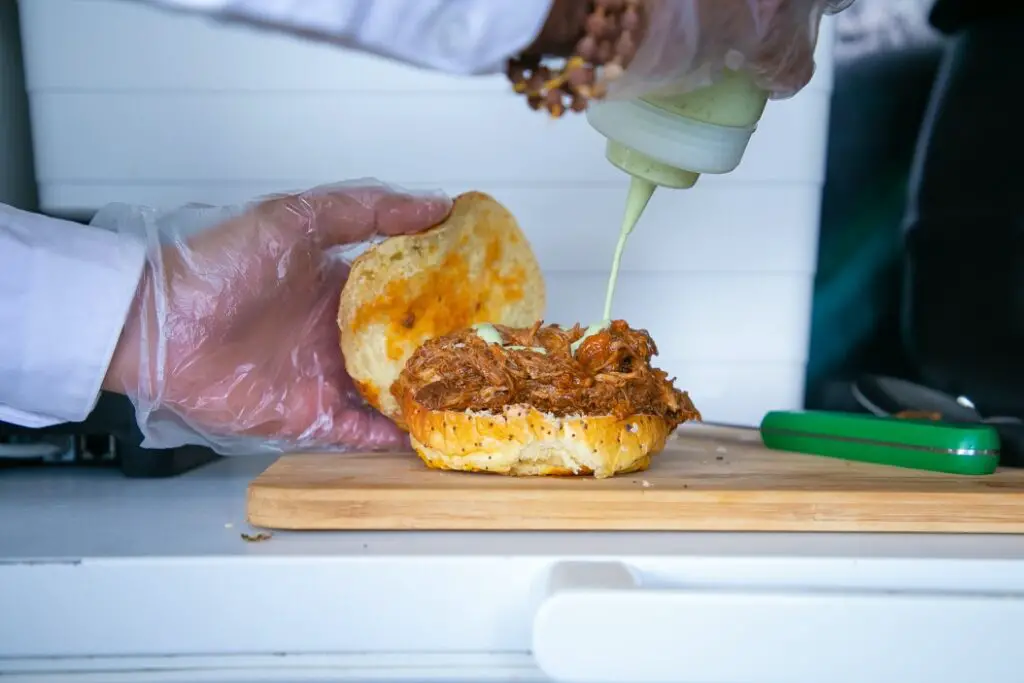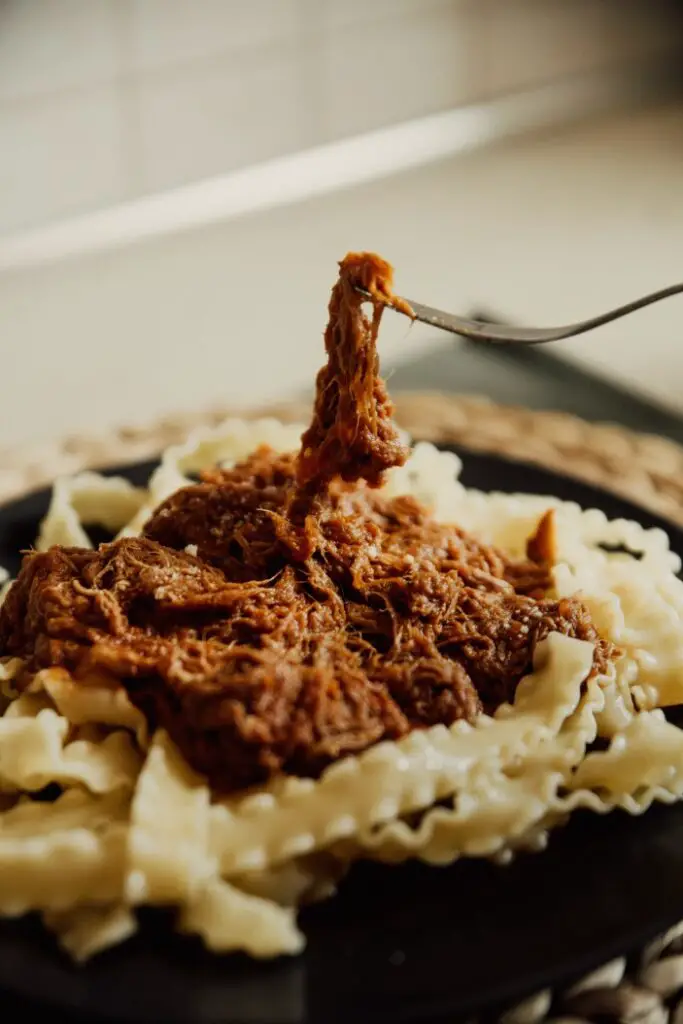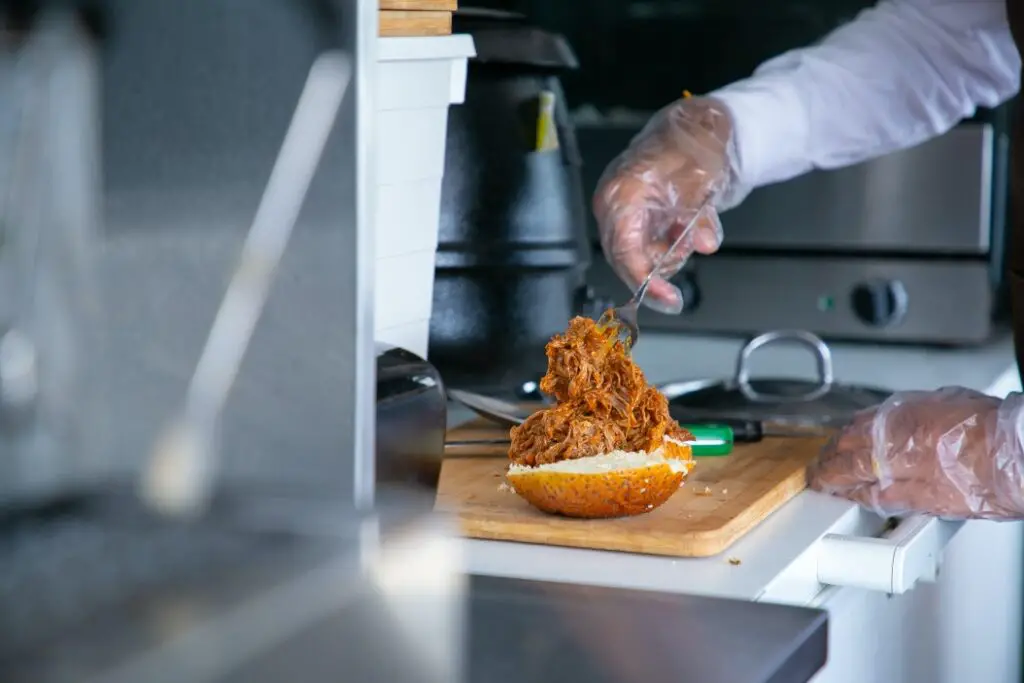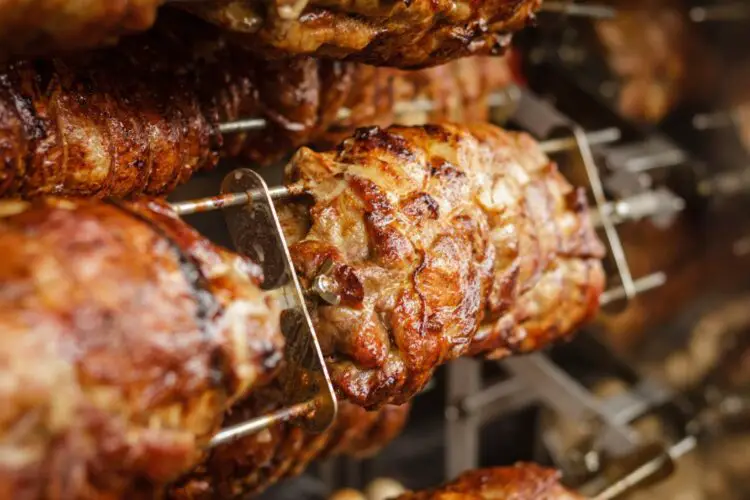Pulled pork is one of the most beloved barbecue dishes in the United States, especially in the South. It has a long history dating back hundreds of years. The origins of pulled pork can be traced back to the 1500s when Spanish explorers brought pigs to what is now the southeastern United States. The native people and early settlers learned cooking techniques like barbacoa from the Spanish, where meat is cooked low and slow over a smoky fire. This style of barbecue was well-suited for cooking tough cuts of meat like pork shoulders.
When catering pulled pork for 50 people, plan on providing at least 16-20 pounds of finished, cooked meat. As a general rule, each adult guest will eat around 1/3 pound of pulled pork. Pork shoulder loses 40-50% of its weight during the long, slow cooking process as moisture evaporates and fat renders out. So to end up with 16-20 pounds cooked, purchase 33-40 pounds of raw pork shoulder. Bone-in cuts like Boston butt yield slightly less finished meat per pound than boneless shoulder roasts
How Much Pulled Pork to Prepare or Serve at a Party?
| Number of Guests | Raw Meat Required (lbs) | Cooked Meat Required (lbs) |
|---|---|---|
| 1 Person | 0.5 | 0.25 |
| 5 People | 2.5 | 1.25 |
| 10 People | 5 | 2.5 |
| 15 People | 7.5 | 3.75 |
| 20 People | 10 | 5 |
| 25 People | 12.5 | 6.25 |
| 30 People | 15 | 7.5 |
| 35 People | 17.5 | 8.75 |
| 40 People | 20 | 10 |
| 45 People | 22.5 | 11.25 |
| 50 People | 25 | 12.5 |
| 75 People | 37.5 | 18.75 |
| 100 People | 50 | 25 |
| 200 People | 100 | 50 |
Pulled Pork Origins in the US:
The term “pulled pork” comes from the method of shredding the cooked pork by hand, “pulling” it into tender strands. It eventually became popular in places like Tennessee and the Carolinas. By the 1980s, pulled pork had spread through the South and become a staple of barbecue restaurants. The pork shoulder is smoked or roasted until extremely tender. Then the meat is pulled or shredded into strands and mixed with a barbecue sauce. It is classically served on a bun with coleslaw as a delicious sandwich.
Part of what makes pulled pork so special is the cut of meat. Pork shoulder, also called Boston butt, has a high amount of fat and connective tissue. This makes it ideal for the low and slow cooking method that tenderizes the meat. The end result is succulent, smokey, and melt-in-your-mouth tender. Pulled pork is the ultimate comfort food, bringing people together at backyard barbecues and restaurants throughout the country. When serving a crowd, pulled pork is a fantastic choice because it can easily be made in large quantities. With the right preparation and cooking technique, you can ensure your guests enjoy authentic, mouthwatering pulled pork.
Selecting the Best Cut of Meat
Opt for a pork shoulder, also known as a Boston butt or pork butt. This cut comes from the upper part of the front leg/shoulder of the pig. It contains a good amount of fat and connective tissue, which breaks down during the long cooking process to make the meat incredibly moist, tender, and shred-able.
Pork shoulder can be purchased bone-in or boneless. Bone-in may have a little more flavor, but boneless is often easier to work with. Look for a pork shoulder that has a good distribution of fat throughout the meat, rather than large chunks of fat on the edges. The fat should make up about 20-30% of the weight. For easy shredding, choose a pork shoulder roast that is at least 4 pounds or larger. Inspect the meat and check that it looks fresh with no unpleasant odors. The color should be pinkish-red. You can also use a pork picnic shoulder, though it may have more connective tissue and require longer cooking.
In summary, look for a boneless or bone-in pork shoulder roast that is at least 4 pounds with evenly distributed fat marbling. This cut will yield tender, flavorful pulled pork after low and slow cooking.
Keeping Pulled Pork Moist and Tender

To keep pulled pork moist and tender while cooking, it’s essential to use the right techniques for each cooking method. Here are some tips for maintaining moisture and tenderness when cooking pulled pork in a smoker, slow cooker, or oven:
Smoker
- Use a water pan: Place a pan filled with water in the smoker to maintain humidity and prevent the meat from drying out.
- Spritz the meat: Periodically spray the pork with apple cider vinegar or apple juice to keep the surface moist.
- Wrap the meat: When the pork reaches an internal temperature of around 160°F, wrap it in aluminum foil or butcher paper to lock in moisture and prevent it from drying out.
Slow Cooker
- Use a flavorful liquid: Add a small amount of liquid, such as chicken broth, apple juice, or a vinegar-based sauce, to the slow cooker to help maintain moisture.
- Cook on low: Cook the pork on low heat for a longer time to ensure tenderness and prevent drying.
- Don’t overcook: Monitor the internal temperature of the meat and remove it from the slow cooker when it reaches the optimal temperature (usually around 195-203°F).
Oven
- Cook low and slow: Cook the pork at a low temperature (around 300°F) for a longer time to break down connective tissues and keep the meat tender.
- Baste the meat: Periodically baste the pork with its own juices or a flavorful liquid to keep the surface moist.
- Wrap the meat: Similar to the smoker method, wrap the pork in aluminum foil or butcher paper when it reaches an internal temperature of around 160°F to lock in moisture
Common Mistakes to Avoid When Cooking Pulled Pork
Cooking delicious pulled pork that is tender, juicy, and full of flavor takes patience and care. While pulled pork may seem simple on the surface, there are some key mistakes that can easily be made along the way. Avoiding these common errors will help ensure your pulled pork turns out perfectly every time. From choosing the right cut of meat to monitoring the internal temperature, small details make a big difference. This section will outline the top mistakes to steer clear of when making pulled pork, so you can avoid potential pitfalls and enjoy mouthwatering barbecue each time. Following some basic guidelines will take your pulled pork from dry and tough to succulent perfection.
Choosing the Wrong Cut of Meat
The optimal cut of meat for pulled pork is pork shoulder, also called Boston butt or pork butt1. This cut comes from the upper part of the front leg of the pig. It contains a lot of fat and connective tissue which breaks down during the low and slow cooking process, resulting in very tender and juicy pulled pork. Choosing a leaner cut of pork like loin or tenderloin will result in dry and tough pulled pork because those cuts don’t have enough fat or collagen.
Underseasoning the Pork
Properly seasoning the pork with a dry rub or wet marinade is crucial for developing flavor. The spice rub permeates the meat over the long cooking time. Too little seasoning results in bland pulled pork. A good rule of thumb is to liberally coat all surfaces of the pork with your favorite spice mix. Let it sit for at least 30 minutes or up to overnight before cooking. The pork will absorb the flavors in the rub.
Trimming Too Much Fat
You don’t want to trim all the fat off the pork shoulder because the fat bastes the meat while it cooks, keeping it incredibly moist and tender. Leave about 1⁄4 inch of the fat cap intact. Having a little fat on the meat also allows you to remove any unrendered pieces after shredding so the pulled pork isn’t greasy.
Cooking Too Quickly or Not Long Enough
Pulled pork needs to be cooked low and slow to properly break down the collagen. Cooking at too high of a temperature or not allowing enough time will result in tough, chewy meat. Cook the pork at 225-250°F and allow 1-2 hours per pound, until it reaches an internal temperature of 195-205°F. The meat should be so tender it shreds easily with a fork.
Overcooking the Meat
It is possible to overcook pulled pork if the internal temperature goes above 205°F. The meat can dry out, making it difficult to shred. Use a reliable meat thermometer and closely monitor the temperature once it nears 205°F. Remove it from the heat source immediately once it hits this ideal finished temperature.
Popular Side Dishes for Pulled Pork

Pulled pork is often served as a sandwich or main dish, paired with a variety of tasty side dishes. Here are some classic and creative options to consider:
| Category | Side Dishes |
|---|---|
| Breads | Cornbread |
| Biscuits | |
| Honey butter biscuits | |
| Garlic toast | |
| Vegetables | Coleslaw |
| Potato salad | |
| Baked beans | |
| Spicy collard greens | |
| Creamed corn | |
| Steamed corn | |
| Corn on the cob | |
| Green beans | |
| Roasted vegetables | |
| Starches | Mac and cheese |
| Pasta salad | |
| French fries | |
| Hush puppies | |
| Onion rings | |
| Fruits | Applesauce |
| Salads | Macaroni salad |
| Coleslaw | |
| Potato salad | |
| Pasta salad |
This wide variety of side dishes offers different flavors, textures, and colors to complement the savory pulled pork. Choose options based on preferences, diet needs, and what is in season. Let me know if you need any additional suggestions for side dishes that pair well with pulled pork!
How Much Pulled Pork Should I Make for a Large Barbecue Using the Ultimate Barbecue Hacks?
When planning a large barbecue, it’s essential to ensure you have enough pulled pork for all your guests. Using the ultimate barbecue hacks can help you make the perfect amount of pulled pork. Aim for 1/2 pound per person if it’s the main dish, and adjust as needed based on your menu.
Here are a Few Suggestions for Choosing Side Dishes that Complement Pulled Pork:
- Include a variety of textures – Pair the tender pulled pork with crunchy sides like coleslaw, onion rings, or apple salad. Crispy cornbread or biscuits also provide contrast.
- Vary the flavors – Tangy, vinegar-based sides like potato salad and coleslaw balance the richness of the pork. Sweet options like baked beans, corn pudding, or fruit salads also work well.
- Consider lighter sides – While pulled pork is heavy, sides like cucumber salad, grilled vegetables, or a fresh green salad provide brightness.
- Think about universal appeal – Choose a few sides that will appeal to everyone like mac and cheese, french fries, or cornbread.
- Mix colors and shapes – For visual appeal, select sides with contrasting colors and shapes compared to the shredded pork.
- Check for dietary needs – Offer vegetarian-friendly sides and avoid common allergens if needed. Baked beans, potato salad, and coleslaw are versatile options.
- Embrace regional flavors – Play up your location with sides like hushpuppies, collard greens, or elote-style corn.
- Offer variety – Provide 3-4 different side options so guests can customize their plates.
With a balanced mix of classic and creative sides, you can design a delicious pulled pork meal. Let me know if you need any specific side dish recommendations!

Regional Variations
There are some regional variations in the side dishes commonly served with pulled pork in different parts of the United States. From North Carolina to Hawaii, each region has its unique take on what complements pulled pork best.
There are some regional variations in the side dishes commonly served with pulled pork in different parts of the United States. Here are a few notable regional differences:
- In North Carolina and other parts of the South, coleslaw, hushpuppies, baked beans, and cornbread are classic sides for pulled pork barbecue. The vinegar-based coleslaw provides a tangy contrast to the rich pork.
- In Memphis, Tennessee, pulled pork is typically served with baked beans, coleslaw, potato salad, and white bread. The potato salad often contains mustard and eggs.
- In Texas, sides may include pinto beans, potato salad, macaroni salad, and pickles. The potato and macaroni salads are more mayonnaise-based.
- In Kansas City, burnt ends baked beans, cheesy corn, and pickles are common sides. The baked beans are sweeter and contain chunks of burnt ends.
- In Hawaii, pulled pork is often served with sides like macaroni salad, rice, and a green salad. The mac salad contains mayo, vinegar, and vegetables.
So while some sides like baked beans and coleslaw are universal, the specific preparations and popularity of certain sides depend on regional barbecue styles and influences. Exploring different regional sides can add variety to a pulled pork meal.
What is the recommended serving size for a large group for pulled pork at a barbecue?
When hosting a pizza party amount of pulled pork at a barbecue, the recommended serving size for a large group is about 1/2 pound of meat per person. This should ensure that there is enough to go around and that everyone leaves satisfied without overindulging.
Conclusion
Pulled pork is a quintessentially American dish that has been embraced across the country, yet modified to suit local tastes and ingredients. The array of delicious side dishes served alongside pulled pork from North Carolina’s tangy coleslaw to Hawaii’s smooth avocado salsa reflect the diversity of American cuisine. While the tender, sauce-laden pork itself remains the star of the show, the sides each region favors complement and complete the meal.
Ultimately, the popularity of pulled pork owes both to its adaptability and its spirit of community. The meat takes well to sweet and tangy barbecue sauces, spicy rubs, and smoky flavors from a variety of wood chips. More importantly, pulled pork lends itself to casual, communal dining, bringing people together over mouthwatering barbecue and sides they can share. Whether served on a picnic table in the Carolinas or a luau in Hawaii, pulled pork brings people together through a common love of finger-licking, melt-in-your-mouth barbecue.
The next time you enjoy pulled pork, take a moment to savor not just the meat, but the connections enabled by this versatile dish. From the chef who prepared it to the company who gathers to enjoy it, pulled pork is so much more than the sum of its (admittedly delicious) parts. Its popularity is rooted in its ability to create community, one perfect bite at a time.


Pingback: How To Plan a Vegetable Platter to Feed a Crowd (30)? - Whaley Cooks